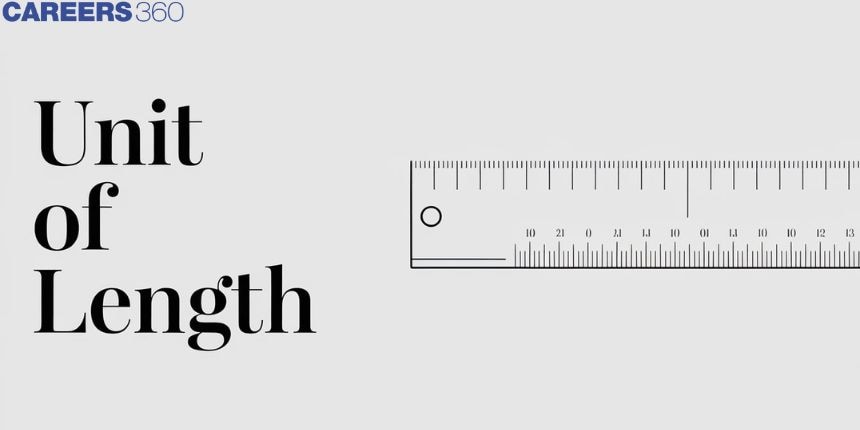Unit of Length - SI Unit and Other Common Units
Here, in this article we are going to discuss SI unit of length, unit of length, standard unit of length, what the standard unit of length is, what is the SI unit for length, what the SI unit of length is, what is the standard unit of length, what SI unit of length is, what is the unit of length, basic unit of length, the basic unit of length is, what is the basic unit for length, all units of length, which unit is not for length, name the SI unit of length, What SI unit of length is called, define length in physics, what the standard unit of length is called, meter is the standard unit of, fundamental unit of length in the metric system etc.
This Story also Contains
- What Is the SI Unit of Length?
- Define length in physics
- Why Do We Need Different Measuring Instruments?
- Large Units of Length
- Small Units of Length
- All Metric Units of Length
- Special Units of Length

Also read -
What Is the SI Unit of Length?
The SI unit of length is the metre (m).
It is the globally accepted and scientifically standardized unit for measuring distance and height.
Define length in physics
In physics, length is defined based on a universal constant.
Length is the distance travelled by light in a vacuum in 1/299,792,458 seconds.
What is the standard unit of length?
The standard unit of length is meter (m).
CGS unit of length
The CGS unit of length is centimeter (cm).
MKS unit of length
The MKS unit of length is meter (m).
Why Do We Need Different Measuring Instruments?
The choice of measurement tool depends on the accuracy and range needed.
Meter scale: Minimum measurable length = 1 mm
Vernier caliper: Least count = 0.01 cm
Screw gauge: Least count = 0.001 cm
Measuring tape: Used for long lengths like cloth or body measurements
For example:
A vernier caliper is better for measuring the diameter of a small rod, while a tape is ideal for measuring the length of a room.
Large Units of Length
1. Astronomical Unit (AU)
$$
1 \mathrm{AU}=1.496 \times 10^{11} \mathrm{~m}
$$
Used to measure distances within the solar system.
2. Light Year (ly)
$$
1 \mathrm{ly}=9.46 \times 10^{15} \mathrm{~m}
$$
Distance travelled by light in one year.
3. Parsec (pc)
$$
1 \text { parsec }=3.08 \times 10^{16} \mathrm{~m}
$$
Used in astronomy for measuring interstellar distances.
Also Read:
- NCERT solutions for Class 11 Physics Chapter 2 Units and Measurement
- NCERT Exemplar Class 11 Physics Solutions Chapter 2 Units and Measurement
- NCERT notes Class 11 Physics Chapter 2 Units and Measurement
Small Units of Length
| Unit | Symbol | Value |
| Fermi | fm | 1 fm = 10⁻¹⁵ m |
| Angstrom | Å | 1 Å = 10⁻¹⁰ m |
| Micron | µm | 1 µm = 10⁻⁶ m |
| Nanometre | nm | 1 nm = 10⁻⁹ m |
| Millimetre | mm | 1 mm = 10⁻³ m |
All Metric Units of Length
Here are the complete metric units used for measuring length:
- kilometre (km)
- hectometre (hm)
- decametre (dam)
- metre (m)
- decimetre (dm)
- centimetre (cm)
- millimetre (mm)
- micrometre ( $\mu \mathrm{m}$ )
- nanometre (nm)
Special Units of Length
1. 1 fermi $(\mathrm{fm})=10^{-15} \mathrm{~m}$
Used to measure nuclear radius.
2. 1 angstrom $(A)=10^{-10} \mathrm{~m}$
Used to measure wavelengths of light and atomic sizes.
3. 1 astronomical unit(AU) $=1.496 \times 10^{11} \mathrm{~m}$
4. 1 light year (ly) $=9.46 \times 10^{15} \mathrm{~m}$
5. 1 parsec $(\mathrm{pc})=3.08 \times 10^{16} \mathrm{~m}$
Also check-
- NCERT Exemplar Class 11th Physics Solutions
- NCERT Exemplar Class 12th Physics Solutions
- NCERT Exemplar Solutions for All Subjects
NCERT Physics Notes:
Frequently Asked Questions (FAQs)
Option (D) is not the unit of length .Newton is the unit of force.
We define length in physics as the length of the path travelled by light in a vacuum in 1⁄299792458 seconds.
Meter is the standard unit of length.
The standard unit of length is meter (m).
The fundamental unit of length in the metric system or MKS system is meter (m).
The length of an object is measured in metres. One metre is equal to the length of path travelled by light in vacuum in time interval 1/299,792,458 of a second. Since the value is always the same, it is a fundamental quantity.
We can measure the distance of a star that is 50 light years away using the parallax method. The star will be observed from two different locations on earth and by measuring the distance between both the locations and angle subtended by the star on both positions, the star distance can be calculated. This method cannot be used to measure a star which is more than 100 light years as the accuracy of the result is not achieved. Thus, we cannot measure the star 150 light years away from us using the same method.